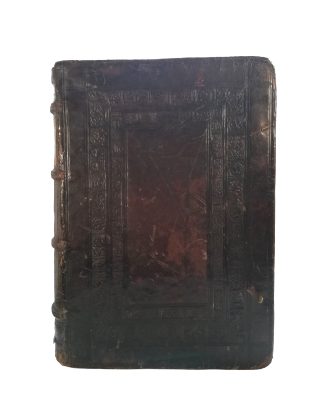ALBERTUS MAGNUS.
De animalibus libri vigintisex novissime impressi.
Venice, heirs of Octavianus Scotus, 1519£6,500.00
Folio, ff. (vi) 205 (i). Gothic letter, double column. Half title, printer’s device to verso of last, woodcut floriated initials. Slight age yellowing to first gathering, intermittent light waterstain to upper and lower blank margins, occasional minor marginal fingersoiling and foxing, very minor ink stains to 1 leaf. A good copy in contemporary English calf over boards, minor loss at corners and greater at head and tail of spine. Covers double blind ruled to a panel design, second border with roll of heads in roundels, third border with roll of decorative ornaments, traces of ties. Spine with double blind ruled raised bands, a bit rubbed at joints, gilt title label. C14 manuscript stubs from a Roman Missal. Label of Harold E. Matthews to front pastedown, C18 armorial bookplate beneath.
A good copy of this fascinating treatise on animals, printed in Venice by the heirs of the distinguished Octavianus Scotus, in a beautiful English contemporary, probably London, binding. The two ornamental rolls appear not to have been identified by Oldham.
A German Dominican friar, bishop and philosopher, Albertus Magnus (c. 1200-1280) is regarded as the most learned and prolific scholar of the Middle Ages, the only one to whom the epithet ‘Magnus’ (‘The great’) was applied. Known by his contemporaries as the “Doctor universalis”, he was later beatified and proclaimed Doctor of the Church. Albertus was active in almost all departments of learning, and the influence of his writings and commentaries on theology, logic, metaphysics, psychology, and the natural sciences was immense. “He combined elements of Aristotelism, Neo-Platonism, Christian theology and Muslim and Jewish philosophy, which he formed into one great system; but his chief aim as a philosopher remained the reconciliation of Aristotelianism with Christian teaching. […] Thomas Aquinas attended his lectures, and Dante placed both master and pupil among the ‘Spiriti Sapienti’ in the heaven of the sun” (PMM 17).
This remarkable work on zoology in 26 books is Albert’s longest commentary on Aristotle’s natural treatises, which also integrates material from Thomas of Cantimpré’s encyclopedic ‘On the Nature of Things’ and Albert’s own studies on animals. Albert began to observe the habits of animals during childhood, and, in contrast to the long-established tradition of bestiaries in which creatures were described in an allegorical way, in his ‘De animalibus’ he presents the behaviours and physiognomy of animals on the basis of empirical observation. The first 19 books recount the contents of Aristotle’s ‘Historia animalium’, ‘De partibus animalium’ and ‘De generatione animalium’, dealing with the anatomy and physiology of different animals compared to humans, their reproduction and life cycle, and the procedures to be followed when studying them. Books XX-XXI contain Albertus’ synthesis of the previous. Finally, books XXII-XXVI constitute a dictionary of animals, in which separate sections are dedicated to quadrupeds, acquatic animals, serpents and ‘vermins’, listed in alphabetical order and individually described. In all, there are 477 species in this encyclopaedia. Remarkably, Albert is the first naturalists to describe the garden dormouse, the marten, the weasel and the rat. He recognised three types of European squirrel before the concept of subspecies was introduced into biology, and he is also the first writer to portray whales in realistic terms. Although this is not a medical text, a wide range of therapeutic data is also included, particularly in relation to the diseases of horses and falcons, which Albertus knew very well from his personal experience.
USTC 808371; Adams A524; Durling 94; Wellcome I, 128; Stillwell 566; not in Brunet or Graesse. See PMM 17 for first ed. J.B. Oldham, English Blind Stamped Bindings (Cambridge 1952)In stock






